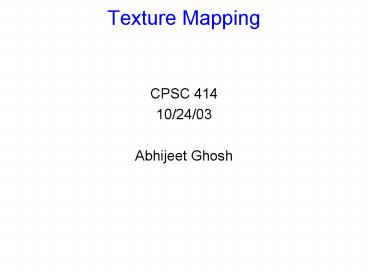Texture Mapping - PowerPoint PPT Presentation
1 / 25
Title:
Texture Mapping
Description:
create bumpy effect on surface. Texture Pipeline. Compute object space location ... projector function converts reflection vector (x, y, z) to texture image (u, v) ... – PowerPoint PPT presentation
Number of Views:92
Avg rating:3.0/5.0
Title: Texture Mapping
1
Texture Mapping
- CPSC 414
- 10/24/03
- Abhijeet Ghosh
2
The Rendering Pipeline
3
Texture Mapping
- Associate 2D information with 3D surface
- Point on surface corresponds to a point in the
texture - Introduced to increase realism
- Lighting/shading models not enough
- Hide geometric simplicity
- map a brick wall texture on a flat polygon
- create bumpy effect on surface
4
Texture Pipeline
Compute object space location
Use projector function to find (u, v)
Use corresponder function to find texels
Apply value transform function (e.g., scale, bias)
Modify illumination equation value
5
Texture Pipeline
v
eye
Texel color (0.9,0.8,0.7)
u
(x, y, z) Object position (-2.3, 7.1, 17.7)
(u, v) Parameter space (0.32, 0.29)
Texture Image space (81, 74)
6
Texture Mapping
t
(s2,t2)
1
(s0,t0)
(s1,t1)
0
s
0
1
(s, t) parameterization in OpenGL
7
Texture Mapping
- Texture Coordinates
- generation at vertices
- specified by programmer or artist
- glTexCoord2f(s,t)
- glVertexf(x,y,z)
- generate as a function of vertex coords
- glTexGeni(), glTexGenfv()
- s ax by cz dh
- interpolated across triangle (like R,G,B,Z)
- well not quite!
8
Texture Mapping
- Texture Coordinate Interpolation
- perspective foreshortening problem
- also problematic for color interpolation, etc.
9
Attribute Interpolation
Bilinear Interpolation Incorrect
Perspective correct Correct
10
Texture Coordinate Interpolation
- Perspective Correct Interpolation
- ?, ?, ?
- Barycentric coordinates of a point P in a
triangle - s0, s1, s2 texture coordinates
- w0, w1,w2 homogeneous coordinates
11
Texture Mapping
- Textures of other dimensions
- 3D solid textures
- e.g. wood grain, medical data, ...
- glTexCoord3f(s,t,r)
- 4D 3D time, projecting textures
- glTexCoord3f(s,t,r,q)
12
Texture Coordinate Transformation
- Motivation
- Change scale, orientation of texture on an object
- Approach
- texture matrix stack
- 4x4 matrix stack
- transforms specified (or generated) tex coords
- glMatrixMode( GL_TEXTURE )
- glLoadIdentity()
13
Texture Coordinate Transformation
- Example
(0,1)
(1,1)
(0,0)
(1,0)
glScalef(4.0,4.0,?)
14
Texture Lookup
- Issue
- What happens to fragments with s or t outside the
interval 01? - Multiple choices
- Take only fractional part of texture coordinates
- Cyclic repetition of texture to tile whole
surfaceglTexParameteri( , GL_TEXTURE_WRAP_S,
GL_REPEAT ) - Clamp every component to range 01
- Re-use color values from border of texture image
glTexParameteri( , GL_TEXTURE_WRAP_S,
GL_CLAMP )
15
Texture Functions
- Once got value from the texture map, can
- Directly use as surface color GL_REPLACE
- Modulate surface color GL_MODULATE
- Blend surface and texture colors GL_DECAL
- Blend surface color with another GL_BLEND
- Specific action depends on internal texture
format - Only existing channels used
- Specify with glTexEnvi(GL_TEXTURE_ENV,
GL_TEXTURE_ENV_MODE, mode)
16
Reconstruction
- How to deal with
- pixels that are much larger than texels ?
- apply filtering, averaging
- pixels that are much smaller than texels ?
- interpolate
17
Mip-mapping
Use an image pyramid to pre-compute averaged
versions of the texture
18
Mip-mapping
- Problem
- A MIP-map level selects the same minification
factor for both the s and the t direction
(isotropic filtering) - In reality, perspective foreshortening (amongst
other reasons) can cause different scaling
factors for the two directions
19
Mip-mapping
- Which resolution to choose
- MIP-mapping take resolution corresponding to the
smaller of the sampling rates for s and t - Avoids aliasing in one direction at cost of
blurring in the other direction - Better anisotropic texture filtering
- Also uses MIP-map hierarchy
- Choose larger of sampling rates to select MIP-map
level - Then use more samples for that level to avoid
aliasing - Maximum anisotropy (ratio between s and t
sampling rate) usually limited (e.g. 4 or 8)
20
Texture Mapping Functions
- Two Step Parameterization
- Step 1 map 2D texture onto an intermediate
simple surface - Sphere
- Cube
- Cylinder
- Step 2 map from this surface to the object
- Surface normal
- Commonly used for environment mapping
21
Environment Mapping
projector function converts reflection vector (x,
y, z) to texture image (u, v)
viewer
n
v
r
environment texture image
reflective surface
22
Spherical Maps Blinn Newell 76
- Transform reflection vector r into spherical
coordinates (?, ?) - ? varies from 0, p (latitude)
- ? varies from 0, 2p (longitude)
- r (rx, ry, rz) 2(n.v)n v
- T arccos(- rz)
- ? arccos(- rx /sinT) if ry 0
- 2p - arccos(- rx /sinT) otherwise
23
Spherical Maps Blinn Newell 76
Slice through the photo
- Each pixel corresponds to particular direction in
the environment - Singularity at the poles!
- OpenGL support GL_SPHERE_MAP
24
Cube Mapping Greene 86
F
A
C
B
E
D
25
Cube Mapping Greene 86
- Direction of reflection vector r selects the face
of the cube to be indexed - Co-ordinate with largest magnitude
- e.g., the vector (-0.2, 0.5, -0.84) selects the
Z face! - Remaining two coordinates (normalized by the 3rd
coordinate) selects the pixel from the face. - e.g., (-0.2, 0.5) gets mapped to (0.38, 0.80).
- Difficulty in interpolating across faces!
- OpenGL support GL_CUBE_MAP































